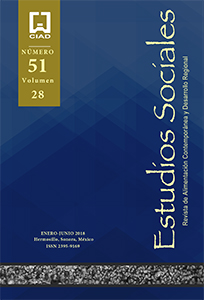La acuicultura frente a los impactos de la actividad agrícola en la calidad de los servicios ambientales de la cuenca del río mayo. Una propuesta para su abordaje desde la economía ecológica.
Aquaculture against the impacts of agriculture in the quality of the environmental services of the mayo river basin. A proposal for its address from the ecological economy
Abstract
Objective: To design an interdisciplinary strategy for the analysis of the environmental impacts of agricultural activity on the efficiency of the aquaculture production system in the Río Mayo basin. Methodology: Exploration of scientific experiences in the treatment of pollution for its synthesis, in a model of intervention at the level of Hydrological Basin, in alignment with the criteria of the ecological economy. We used as reference the analysis of the Mexican Basin of the Rio Mayo; the relationships between the pollution originated in intensive agriculture and its impact on productive systems downstream (aquaculture of the shrimp) are described. Results: An interdisciplinary strategy was constructed to analyze, through hydrological modeling techniques, the interaction of agricultural activity with the main components of the ecosystems, to estimate the remnants of pollution displaced from the productive systems of the basin to the coastal waters and their affectation to the bodies of water that support the aquaculture activity. Limitations: The lack of specialized literature in the casuistic analysis of the interrelationship between economic actors and ecosystems that provide environmental services, demands the integrated effort of the natural sciences and the economy. Conclusions: The adequate technical evaluation of the analyzed phenomenon is conditioned to the abandonment of the prevailing economic paradigm, that obliterates the biophysical and social dimension of the problems that the own economic processes generate.Keywords: regional
Keywords:
Regional development, hydrological basin, pollution, environmental impact, ecological economy, shrimp farming.Abstract
Objective: To design an interdisciplinary strategy for the analysis of the environmental impacts of agricultural activity on the efficiency of the aquaculture production system in the Río Mayo basin. Methodology: Exploration of scientific experiences in the treatment of pollution for its synthesis, in a model of intervention at the level of Hydrological Basin, in alignment with the criteria of the ecological economy. We used as reference the analysis of the Mexican Basin of the Rio Mayo; the relationships between the pollution originated in intensive agriculture and its impact on productive systems downstream (aquaculture of the shrimp) are described. Results: An interdisciplinary strategy was constructed to analyze, through hydrological modeling techniques, the interaction of agricultural activity with the main components of the ecosystems, to estimate the remnants of pollution displaced from the productive systems of the basin to the coastal waters and their affectation to the bodies of water that support the aquaculture activity. Limitations: The lack of specialized literature in the casuistic analysis of the interrelationship between economic actors and ecosystems that provide environmental services, demands the integrated effort of the natural sciences and the economy. Conclusions: The adequate technical evaluation of the analyzed phenomenon is conditioned to the abandonment of the prevailing economic paradigm, that obliterates the biophysical and social dimension of the problems that the own economic processes generate.Keywords: regional
Keywords:
Regional development, hydrological basin, pollution, environmental impact, ecological economy, shrimp farming.Downloads
Published
How to Cite
Issue
Section
Para que sean publicados artículos, ensayos y reseñas críticas en Estudios Sociales, la revista debe contar con la aceptación de parte de los autores/autoras de las condiciones siguientes:
1. Los autores conservan los derechos de autor y ceden a la revista el derecho de la primera publicación del trabajo registrado bajo la licencia de Creative Commons Reconocimiento-NoComercial (CC-By-NC) que permite a terceros utilizar lo publicado, siempre y cuando mencionen la autoría del trabajo y a la primera publicación en esta revista.
2. Los autores pueden realizar otros acuerdos contractuales independientes y adicionales para la distribución no exclusiva de la versión del artículo publicado en esta revista (por ejemplo: incluirlo en un repositorio institucional o publicarlo en un libro) siempre y cuando indiquen, claramente, que el trabajo se publicó por primera vez en esta revista.




















